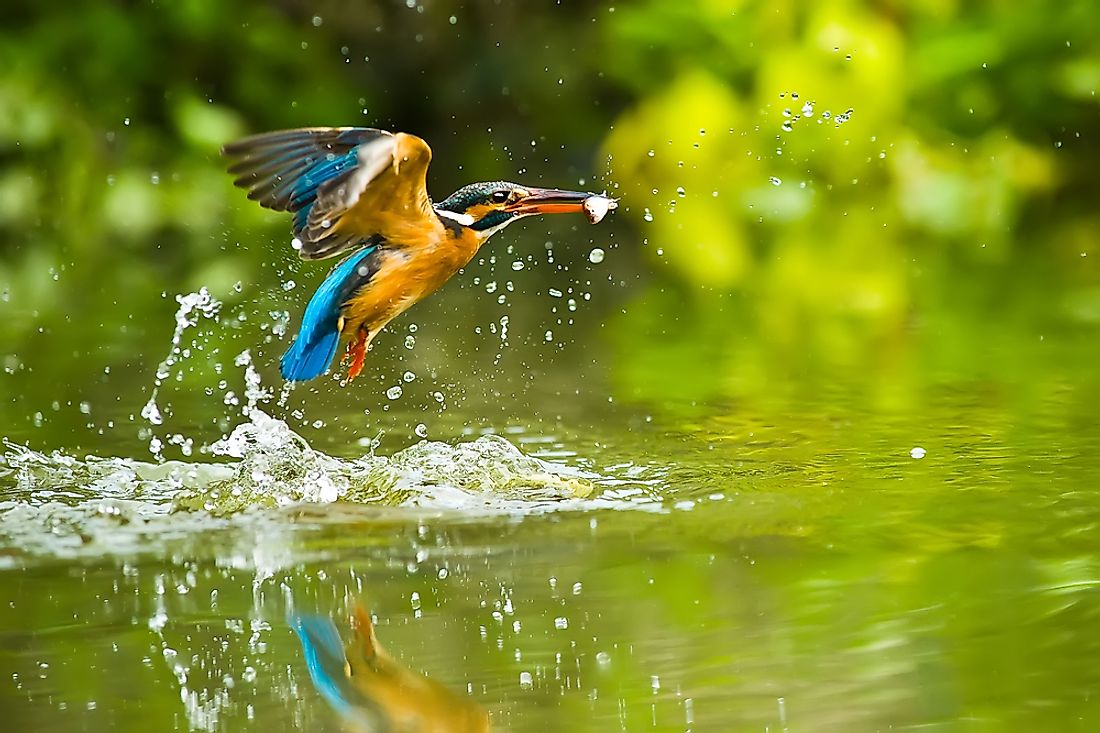What Is A Kingfisher?

Kingfishers are a type of bird that belong to Chordata phylum, Coraciiformes order, and Alcedinidae family. The species is known for its brightly-colored feathers, which range from bright blue, turquoise, gold, orange to brown, and often lives near still or slow-moving bodies of water where they hover or perch above the surface in search of fish, which constitutes the majority of their diet. Kingfishers dart out toward prey and snap it using their dagger-shaped long bills and then fly back to their perch to eat. Kingfishers nest in cavities, like most members of their order, and tend to be most active during the morning and early evening. Although the species can be found throughout the world, most live in tropical areas.
Description
A unique characteristic of the kingfisher is its dagger-shaped long bill that appears too large for its body size. Their legs are short but strong due to the fact that they spend a lot of time perched on branches or twigs. The bird has four toes, three of which point forward. Kingfishers have binocular vision and can see colors well, which enables them to see into the water despite the refraction effect. The species moves its head while tracking prey due to restricted eye movement within the socket, and a nictitating membrane covers its eyes for protection when entering the water to catch prey. A kingfisher can be completely submerged in water as it dives for fish, and will fold its wings to form a V shape, which allows it to reach fish that are several meters below the water surface. Some kingfishers have even been observed diving through thin layers of ice to catch fish. The giant kingfisher and the African dwarf kingfisher are the largest and smallest kingfisher species, measuring 18 inches and 3.9 inches tall, respectively.
Distribution and Habitat
Kingfishers live in diverse ecosystems across the world. They thrive both in temperate and tropical regions but are absent in the driest deserts and the polar regions. Despite the fact that kingfishers are associated with bodies of water, some species live in forested regions and others in high mountains or open woodlands. Some can even survive in human-modified habitats such as cultivated lands, parks and gardens.
Behavior and Ecology
As the name suggests, most kingfisher species feed on fish. However, other species feed on a wide range of food items depending on the habitat. Forest and woodland kingfishers feed mostly on grasshoppers, spiders, mollusks, amphibians, worms, and even snakes. Kingfishers are naturally monogamous and territorial. As cavity nesters, some dig holes on the ground near water bodies, ditches, in tunnels, or in the holes of trees. Kingfishers lay an average of 3 to 6 eggs, depending on the species, which are incubated by both the male and female for 2 to 4 weeks.
Conservation
The continued existence of a number of kingfisher species is significantly threatened by human action. For example, the drying of wetlands and water bodies leads to diminishing sources of food. The forest species face the biggest risk of extinction due to habitat loss. Introduced species, such as brown snakes on the island of Guam, led to a rapid decline in the population of rare species of kingfisher. Four species of kingfisher are listed as critically endangered.











